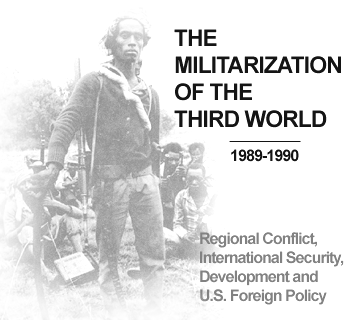- About this Program
- 2012 Conflict in the 21st Century
- 2011 Our Nuclear Age: Peril and Promise
- 2010 South Asia: Conflict, Culture Complexity, and Change
- 2009 Cities: Forging an Urban Future
- 2008 Global Poverty and Inequality
- 2007 Global Crises: Governance and Intervention
- 2006 The Politics of Fear
- 2005 Oil and Water
- 2004 Dilemmas of Empire and Nation Building
- 2003 Sovereignty and Intervention
- 2002 Global Inequities
- 2001 Race and Ethniciity: A Global Inquiry
- 2000 Global Games: Sports, Politics, and Society
- Symposium
- 1999 Global Crime, Corruption, and Accountability
- 1998 Exodus and Exile: Refugees, Migration, and Global Security
- 1997 The Future of Democracy
- 1996 Religion, Politics, and Society
- 1995 20/20 Visions of the Future
- 1994 Ethnicity, Religion and Nationalism
- 1993 Transformations in the Global Economy
- 1992 - International Security: The Environmental Dimension
- 1991 Confronting Political and Social Evil
- 1990 The Militarization of the Third World
- International Symposium
- 1989 Drugs, International Security and U.S. Public Policy
- 1988 Foreign Policy Imperatives for the Next Presidency
- 1988 Covert Action and Democracy
- 1987 The West Bank and Gaza Strip
- 1986 International Terrorism
- News
- Press Clips
- Calendar
- Resources
EPIIC Archives
1990 The Militarization of the Third World

|
|
* Some 22 wars have been fought in the 1980s, more than in any previous decade in modern military history.
* Some 127 conflicts since 1945 have killed approximately 20 million people, and injured approximately 48 million more. By the 1980s, civilians constituted 85% of all war deaths.
* The Third World produces almost all the world's refugees. The United Nations High Commission on Refugees only recognizes some 11 million, less than one half of the global refugee population that may total as many as 25 million.
* In the developing world, there is one soldier per 240 inhabitants, one physician per 1,950.
* How credible are charges that Israel and South Africa are collaborating on ballistic and nuclear development programs?
* Will arms cuts in Europe produce a dumping of surplus conventional weaponry in the Third World? Will arms producers need to seek profits in the Third World, stoking overt and covert arms races?
Staggering casualties, displaced peoples, refugees, devastating famine, unrelieved debt, and distorted social structures are the drastic political, human and societal consequences of militarization. We scrutinized the role of U.S. foreign policy in regional conflicts -- e.g. Angola, Cambodia, El Salvador, the Horn of Africa, India/Pakistan, Israel/Palestine and the Persian Gulf -- as well as the nuclear and conventional arms races threatening fragile ceasefires and exacerbating seemingly intractable wars.
Will the world be more or less secure as the Cold War abates? In the context of shifting East-West/North-South relations, the symposium probed the causes and costs of the world's "hidden wars." These foreign interventions, civil wars, "national liberation" struggles, and nation vs. state insurgencies are conflicts that are hard to reach, expensive to report, difficult to explain, and are dismissed as "irrational" ethnic, religious conflicts or are recast in the mold of democracy vs. communism. The Third World War is hidden from view because the fighting is against peoples and countries that are often not even on the map. In this war, only half of the geography is shown and only one side of the fighting has a nam

